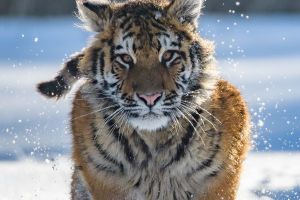The crane, which represents elegance, good fortune, fidelity, and longevity, is beloved by the Chinese and has become one of the most revered animals in Chinese culture.
It is also one of the most depicted cranes in ancient Chinese poetry, paintings, and other works of art.
The male crane is slightly larger than the female and has a broad gray-black stripe on each side of its neck, a small white patch on its ear feathers, and dark brown irises. Its forehead and top of the head are bare, without feathers, and vermilion.
The throat, neck, and secondary and tertiary flight feathers are black. The beak is yellowish-green, and the tail is short with white tail feathers. The legs and feet are leaden black. The young are pale tawny, but the tips of the primary flight feathers are black, and the neck and secondary flight feathers are dark brown or gray.
During the breeding season, cranes typically choose to roost in reed swamps, mossy lowland marshes, and seasonally waterlogged marshy meadows, where they also tend to nest. In wintering grounds, they inhabit mudflats, rice fields, and reed swamps.
Their diet consists of a wide range of insects, fish, shrimps, crabs, shellfish, and snails, as well as alkali seeds, sedge seeds, and plant roots. They also visit agricultural fields to eat seeds and seedlings, which vary according to the season.
In late February and early March, wild cranes leave their wintering grounds to fly to their breeding grounds. In early October, they leave their breeding grounds in small flocks to migrate to their wintering grounds.
The cranes often move in pairs or family groups and small flocks. During the migration season and in winter, several or dozens of family flocks often assemble into larger groups. Sometimes there are as many as 40-50 birds in a cluster, or even hundreds, but they are still scattered in small groups or family groups within a certain area.
At night, they often roost on shallow banks surrounded by water or along the reeds, but they still roost in family groups. The feeding grounds and nocturnal roosts are generally more fixed. Usually, after dawn, each family flies to the feeding ground one after another, still keeping a certain distance from each other.
When resting, cranes often stand on one leg with their head turned back and tucked between their back feathers. Their calls are very loud and clear and serve as a signal of territoriality and an important form of communication during courtship.
When flying, their heads and feet are straight back and forth, and their wings flutter slowly, often in a single or V-shaped formation.
Breeding season for cranes is from April to June, with a male and female pairing system. Pairing and nesting begin in late March and early April each year. The males and females announce their possession of the domain to each other through constant chirping within the nest area. Generally, two eggs are laid per clutch, occasionally one.
The eggs are oval, pale grey or black and white, with rusty brown or purplish grey spots on the blunt ends. The incubation period is 30 to 33 days.
At the end of the breeding season, the chicks will be able to fly, and as the wintering season approaches, the young will migrate with their parents to their wintering grounds. Sub-adult cranes are usually sexually mature in two years and can live for 50-60 years.
The global wild population of cranes currently stands at around 3,800, including the non-migratory population in Hokkaido, Japan (known as the resident population) and the migratory population on the East Asian continent (the mainland population).
Since 2009, the non-migratory population of Japanese Northern Whooping Cranes has increased from 1,200 to around 1,800, and the mainland population has increased from 1,500 to nearly 2,000.
The main stressors for the whooping crane population include reduced and degraded habitat areas, as well as human disturbance. Large-scale farming activities, polder development, and other anthropogenic activities have led to a certain degree of destruction of the wetland habitat where cranes reside, causing a gradual decline in the area of suitable habitat and its suitability.
We need to take action now to protect cranes because it is still our home that needs protection.


